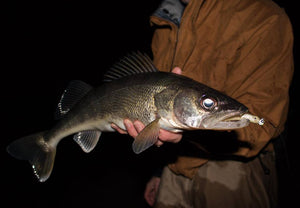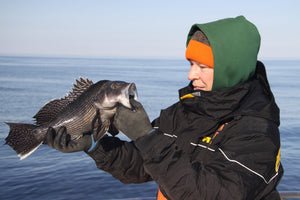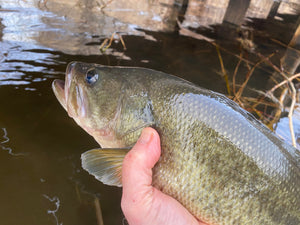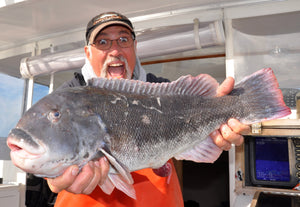Tidal Search for Great White Perch
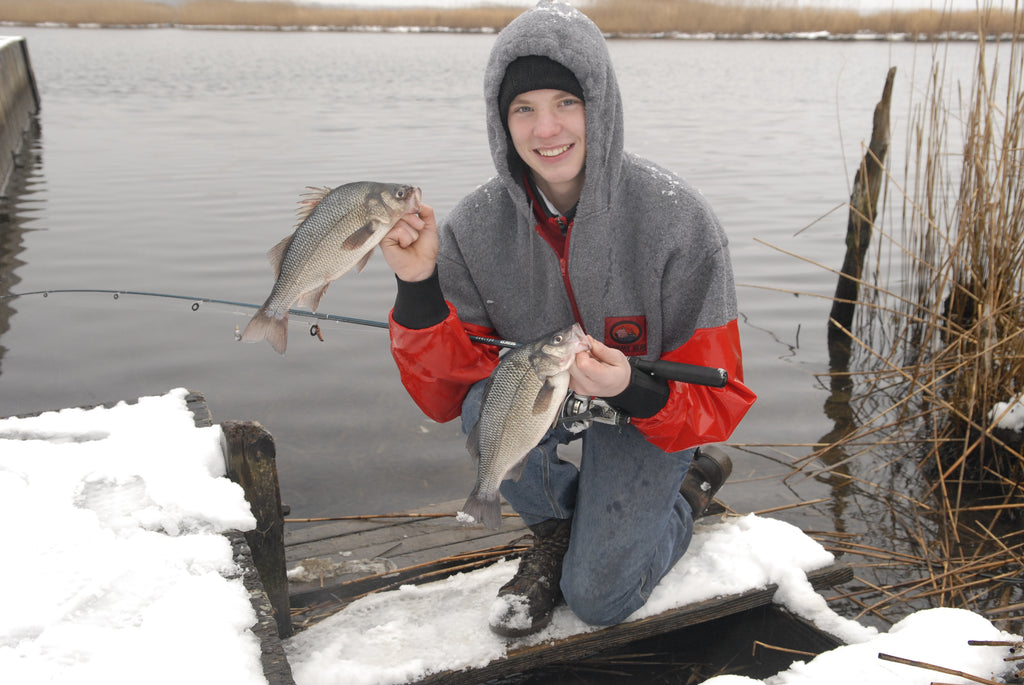
NOW’S THE TIME FOR TIDAL PERCH
By Staff
Have you ever caught a white perch in tidal waters here on Long Island? If you’re looking for a winter challenge, pursuit of these feisty tidal water panfish might be just what it takes to get you suited up and ready to go. The interesting thing with this species isn’t that it grows big, fights hard or tastes great. It’s more the subtle game of hide and seek that piques the imagination of those who fall under its spell. In all honesty, you don’t fish for white perch as much as you hunt for them.
To be sure, a major part of the attraction of winter whites is that they are one of only a few local species found within easy casting distance of the shore throughout the colder months. Still, it’s the thrill of simply finding the pugnacious little finsters that really lights a fire under their fans. As any Long Island white perch veteran will tell you, these fish might occupy any of their usual tidal water hotspots such as Mill Basin, Santapogue Creek, Connetquot River, Carmans River, Nissequogue River, or many other creeks that trickle into the bays one week, and simply vanish the next. In other words, it’s never a sure thing that you’ll be able to find them – which helps explain why white perch fans are often coy about naming where they’ve scored recent catches.

Small spinners, grubs and even ice-fishing jigs will all take white perch, as will grass shrimp or half a night crawler impaled on a size 4 beak style hook. OutdoorTom.com photo.
Then, too, there is the ferocity factor – or lack of same on certain days. When white perch are in a feeding mood they’ll smack spinners, jigs, small balsa or plastic plugs and light-weight spoons. When the bite grows tough, usually during periods of prolonged cold or when the fish are heavily pressured, three-inch segments of night crawler, small live killies, shiners or grass shrimp baits may be needed to ignite their interest.
The possibility of sight fishing is yet another point that draws anglers into this game as these fish sometimes school in shallow water near the head of a creek or just below a dam separating brackish water from fresh. At these times it may even be possible to stalk the pods and cast to them using the long wand and a scud, shrimp or small, sparse epoxy minnow pattern.

Fly-rodders targeting tidal trout often find white perch to be a fun by-catch when using small streamers and bead-head nymphs. OutdoorTom.com photo.
Diminutive cousins of striped bass, white perch (Morone Americana) in our brackish waters can grow to over 17 inches and nearly 3 pounds but typically measure 6 to 10 inches and weigh in at half-a-pound to a pound-and-a-half. Easy to identify, they have silvery flanks with a darker back, small teeth and a slightly projecting lower jaw. Their range covers Nova Scotia to the Carolinas, but they are most numerous from eastern Long Island to Chesapeake Bay. Take the word “numerous,” with a grain of salt as they aren’t as easy to come by these days as in decades past. That means you’ll likely need to make a few trips and try several different areas before meeting with success.
Semi-anadromous, white perch migrate to tidal fresh and slightly brackish waters during the colder months where they’ll spawn later in the spring from March through early June. Males usually mature by age two and females by age three, with females producing from 50,000 - 150,000 eggs over a period of two to three weeks. No flash in the pan, these fish can live for eight to ten years. That means the big ones have been around for a while, a point to be seriously considered if you creel more than a couple.

Light Tackle and white perch go hand-in-hand. Photo by Tim Regan @SouthForkSalt
Despite the challenges associated with working up some winter whites, it’s important to not over-think the process. Basically, these are saltwater panfish and, while being aware of their quarks, you should treat them as such. Start by probing known hot spots, looking for primary pools, dam areas, eddies or the deeper side of a twist in a tidal creek to test the waters. As with many species of fish that inhabit shallow environs, expect the perch to bite best early and late in the day and to show a preference for overcast skies over bluebird days. In areas of significant tidal influence, the start of outgoing water often produces best, although the bottom of the tide shouldn’t necessarily be discounted as it pockets the fish when water draws down.
Of course, it helps to be a little creative during your prospecting. Kayakers and johnboat boat fans, for instance, have a clear advantage over landlubbers because they have access to more water. Still, methodically probing openings along riverbanks and tidal creeks at road ends, parklands, open lots and other access points can bring success even for those who search on foot.
Look for winter whites and an occasional resident school bass to hold in the deepest creek water you can find. Often this will be where creeks bend or pinch and a small swath of bottom is carved away by the current. Don't overlook bridges and culverts as possible honey holes, and any pocket where you catch school stripers or tidal trout in early spring is worth investigating. Above all, don’t be overwhelmed with all the possibilities of where the perch can be found. Pick a spot or two, get a line in the water, and give each potential honey hole a serious try before moving onto the next option.

A simple bottom rig featuring a ¼-ounce bell sinker and size four, pre-snelled beak-style hook tied six to ten inches above the weight is all you need to get started catching white perch. A segment of night crawler or a pair of fresh grass shrimp make great baits. OutdoorTom.com photo.
Rigging for white perch works best if kept simple. When opting for bait instead of lures, use a standard bottom rig with a one-quarter-ounce bell sinker and a size four, pre-snelled beak-style hook tied six to ten inches above the weight. You can cast this rig a mile with six- to eight-pound test line on a spinning setup suited to freshwater trout or panfish action. Half a night crawler works great for bait. If you prefer a greater challenge, opt for four- to six-pound test line and a small spinner or one-eighth-ounce jig-head sporting a small curly-tailed grub. Tip the jig with a piece of worm or, if you can find them along a local bulkhead, a single fresh grass shrimp. These fish also love "Trout Magnet" lures, and shad darts as well.
Be aware that it is possible to put a serious hurt on the perch population by removing too many, so don't get greedy. As noted, the real thrill is in figuring them out. Although there is no size or creel limit on tidal perch, be sure to toss the small ones back and consider releasing some of the bigger breeders you might encounter over the next few months. Many white perch anglers, in fact, release all they catch, helping ensure they’ll still be some around in the years to come.
- Bryce Poyer


